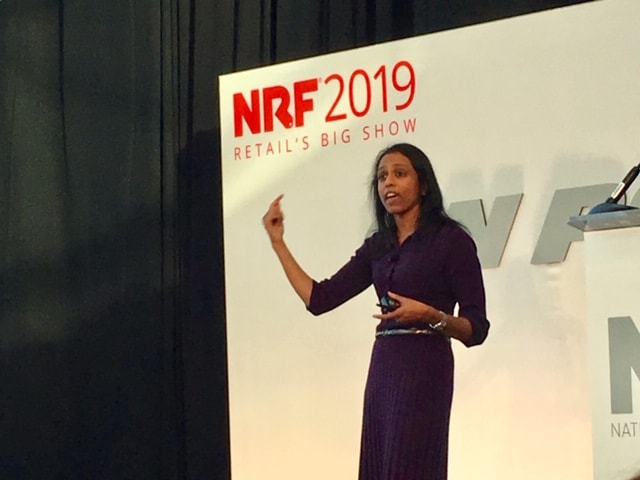One of retail’s keenest observers opened the National Retail Federation’s annual trade show Sunday by throwing one last shovel of dirt on one of 2018’s dominant industry narratives — the death of retail.
“Who said apocalypse?” Sucharita Kodali, a Forrester Research vice president and analyst, said as she dove into a look at where retail innovation is headed in 2019.
Kodali shared Forrester and NRF research that indicated that 57 percent of retail companies will be opening stores this year, compared to 36 percent that will be closing them. The statistics support a number of reports that show more brick-and-mortar stores opened in 2018 than closed.
Which is good news, but.
“Retail, as you know, is cyclical,” she said. “We are headed into a time of uncertainty,” Trade tribulation, economic uncertainty, new privacy regulations and more could combine to create a drag on retail fortunes. But, Kodali said, retailers are heading into 2019 with big plans. Specifically, retailers told Forrester they’d be focused on four areas:
- Growing revenue
- Improving customer experience
- Improving products and features
- Reducing costs
As Kodali herself pointed out, the list is hardly shocking. But where it gets interesting is when you dig into how retailers intend to reach those goals and pair that with some of the other trends Kodali addressed before a fully packed meeting hall at New York’s Jacob K. Javits Convention Center.

The growing revenue and improving customer experience goals, for instance, blended together in many ways. Building a better customer experience, after all, is a key to growing revenue. A better experience not only means more customers spending more; it means more customers coming back to spend more.
Some of the specifics on improving experience that retailers told Forrester about — better personalization, frictionless mobile experiences, ominichannel improvements — are rooted in innovation, something Kodali noted requires investment, which is at odds with the cost reduction goal.
Consider technology’s return on investment
But those goals are also the kinds of things that can be achieved through advances in technology. It is the nature of technology that it not only moves industries into the future, it often creates ways to do things that are cheaper or more profitable. Those are the sorts of technologies retailers will be looking for in 2019.
“There is this need to innovate,” Kodali said. “On the other hand, everybody wants to innovate in the least expensive way possible.”
Specifically, she said, retailers are investing the most heavily in data security, personalization, mobility and cross-channel improvements. Some of retail’s buzziest innovations — things like augmented and virtual reality — are not yet gaining the traction their attention might indicate.
You’d be forgiven for thinking the kinds of things retailers are investing in are the same things they’ve been investing in forever. But, Kodali said, these transformative initiatives do not happen overnight.
“Retailers need to continue to invest in them to ultimately execute on them,” she said. “Any single one of these can take years to nail and get right.”
She pointed to in-store pick up, a service some retailers have been offering for years and one that many say is vital to a true omnichannel strategy.
“Even things like buy online pick up in store, there are relatively few retailers that have fully implemented that,” she said, citing a 42 percent adoption rate.
Much of this future innovation and adoption is likely to be accelerated by another topic that Kodali spent some time analyzing — artificial intelligence and machine learning. Yes, again, they are technologies and topics that have been around for some time. Kodali cited their use in IT performance monitoring , warehouse optimization, determining hiring store efficiency and fraud detection.
Technology solutions will continue to advance
But the science and technology is improving and the use cases are expanding rapidly. More and better chatbots, robo-buyers for merchandising, automated analysis for understanding consumer desires.
Retail is not standing still, even if some of the terminology sounds familiar. There will be big changes. Kodali talked about retailers branching into other businesses the way tech giants like Apple, Amazon, Microsoft and Google have. (Did you know IKEA’s restaurant business is comparable to Red Robin or Carl’s Jr? How about that Walmart is a landlord, renting out chunks of its parking lots to other businesses?)
So, no. Retail is not dying. It’s changing. The eternal question will be: Is it changing fast enough?








